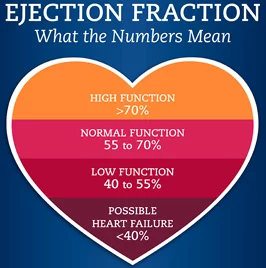Ejection fraction (EF) is a measure of how much blood leaves the heart with each heartbeat.
Every heartbeat cycle has two parts: Contraction and relaxation. When the heart contracts, blood is ejected from two ventricles. During relaxation, the ventricles are filled with blood.
No matter how forceful heart contractions get, they’re never strong enough to pump all the blood out of the ventricles. But the amount of blood the heart is able to eject communicates a lot about a patient’s heart health. Knowing how effectively your heart is pumping blood helps diagnose and track heart failure.
Understanding EF results
The heart mainly pumps blood from the left ventricle (LV) through the aorta to the rest of the body. The EF is typically only measured in the LV. This is known as the Left Ventricle Ejection Fraction (LVEF).
Sometimes, your doctor may decide to measure the amount of blood that leaves the right side of the heart for oxygen in the lungs. This measurement is referred to as the Right Ventricle Ejection Fraction (RVEF).
EF is expressed as a percentage. For example, an EF of 60% shows that 60% of the blood in the LV is ejected from the ventricle with each contraction.
What’s normal and what’s not?
A normal heart’s EF should be between 50–70%.
An EF of 41–49% may be considered low but doesn’t necessarily mean a risk of heart failure. Sometimes, a low EF could be the result of damage caused by a previous heart attack.
But an EF of 40% or below may indicate heart failure or cardiomyopathy. Other reasons why your EF may be low include:
On the other hand, an EF measurement higher than 75% usually indicates a heart condition such as hypertrophic cardiomyopathy.
It’s important to note that EF is just one of the measures of the heart’s effectiveness. Positive EF results don’t necessarily indicate a healthy heart. Some people have normal EF readings but still suffer heart failure, or Heart Failure with preserved Ejection Fraction (HFpEF).
This type of heart failure occurs when the heart muscle becomes so thick that the ventricles hold a smaller volume of blood than they normally can. For example, the LV might still pump 60% of the blood it holds, indicating normal EF. But in reality, the amount of blood the ventricle can hold is low to begin with.
How do you measure ejection fraction?
EF is measured using a variety of imaging techniques such as:
Applies sound waves to develop images of the heart and the blood pumping through the heart.
A thin plastic tube is inserted into the artery in the arm or leg and moved to the heart. Images may be taken during the process.
- Cardiovascular Magnetic Resonance Imaging (MRI)
Uses radio waves and a magnetic field to create images of certain parts of your body. When it’s used to study the heart, it’s also referred to as Cardiovascular MRI.
- Cardiac Computerized Tomography (CT)
A CT scan that uses special X-ray technology to create cross-sectional images of certain parts of your body. When it’s used on the heart, it’s a Cardiac CT.
A radioactive material like thallium is introduced into your bloodstream and traced using special cameras. Despite using radioactive material, the nuclear scan is considered safe.
Should I know my ejection fraction?
Knowing your EF is especially important if you have already been diagnosed with a heart condition. The results of the EF test can be crucial in helping the doctor determine what course of treatment suits you best. Your healthcare provider may also need to know your EF so they can assess the treatment and how effective it is.
Consult your doctor to know how often you need to take an EF test. Generally, you should measure your EF the first time you’re diagnosed with a heart condition. You should then have it measured as needed and as your condition changes.
If you have concerns and would like to get tested to make sure your heart is working efficiently, please schedule a consultation with the specialists at Manhattan Cardiology.



